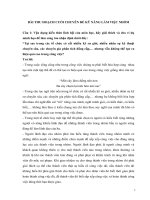Nghe 3 bai thu hoach Kỳ 3
Bạn đang xem bản rút gọn của tài liệu. Xem và tải ngay bản đầy đủ của tài liệu tại đây (61.41 KB, 1 trang )
Họ và tên: Nguyễn Phương Thảo
BÀI THU HOẠCH
MÔN: NGHE TIẾNG ANH III
Task: What do inference questions in listening look like? What strategies can be used to
answer inference questions?
1. Inference questions in listening are concluded based on the basis of give facts. Listeners
have to understand among facts. The facts you listen might not the correct answer.
Inference is always with respect listeners and more than one inference can be drawn on
the basics of given facts. For example:
Choose correct answer:
What is the difference in price between the brass and chrome showerhead?
a.$ 20
b.$70
c.$50
d.$10
You will heard the paragraph like this:
Many people think this is the world’s finest showerhead, and we think you’ll agree. Don’t be fooled by its
simple appearance. Used in 5-star hotels and top health spas, this showerhead delivers a consistent,
efficient 2.5 gallons per minute, regardless of water pressure. It is adjustable from invigorating needle
spray to a full flood. The specially constructed plastic nozzles resist mineral build-up. It installs easily
without special tools. It’s made in the USA and is available in chrome for $50 or brass for $70. For an
additional $10, you can purchase a special mineral salt attachment and 20 mineral tablets. This screw-on
attachment contains a refillable water-softening mineral tablet which will give you health spa grade water
each time you use it. each table is good for at least 25 users.
-
However the question just ask the difference in price of showerhead. You should infer
from the price of “chrome for $50 or brass for $70”. From this fact, you can choose “a.$20”
is a correct answer.
2.
What strategies can be used to answer inference questions
1. Read the question and 4 choices carefully.
2. Don’t be fooled by “half-right” answers.
3. Examine the scope.
4. Pay attention to key words .
5. Ignore the assumptions.









